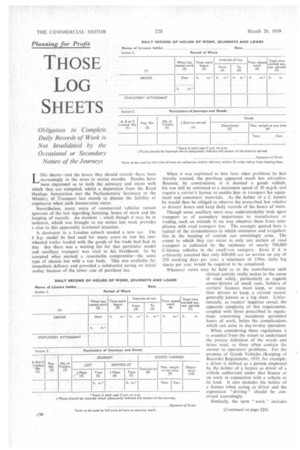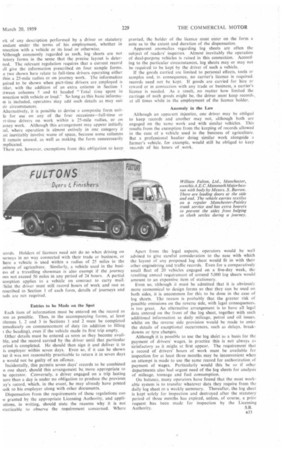THOSE LOG SHEETS
Page 68

Page 71

If you've noticed an error in this article please click here to report it so we can fix it.
Obligation to Complete Daily Records of Work is Not Invalidated by the Occasional or Secondary Nature of the Journeys
LOG sheets—and the hours they should record—have been increasingly in the news in recent months. Doubts have been expressed as to both the accuracy and intent with which they are compiled, whilst a deputation from the Road Haulage Association met the Parliamentary Secretary to the Ministry of Transport last month to discuss the liability of employers when such inaccuracies occur.
Nevertheless, many users of commercial vehicles remain ignorant of the law regarding licensing, hours of work and the keeping of records. An incident small though it may be in isolation, which was brought to my notice last week provides a clue to this apparently irrational situation.
A decorator in a London suburb needed a new car. The 8 h.p. model he had used for many years to tow his twowheeled trailer loaded with the goods of his trade had had its day. But there was a waiting list for that particular model and ancillary transport was vital to his livelihood. So he accepted what seemed a reasonable compromise—the same type of chassis but with a van body. This was available for immediate delivery and provided a substantial saving on initial outlay because of the lower rate of purchase tax. When it was explained to him later what problems he had thereby created, the purchase appeared much less attractive. Because, by construction, it is deemed a goods vehicle, his van will be restricted to a maximum speed of 30 m.p.h. and require a carrier's licence to enable him to transport his equipment and customers' materials. As the holder of a C licence he would then be obliged to observe the prescribed law relative to drivers' hours and keep daily records of his hours of work.
Though some ancillary users may understandably look upon transport as of secondary importance to manufacture or trading, such an attitude in no way absolves them from compliance with road transport law. The example quoted here is typical of the circumstances in which omissions and irregularities in the keeping of records can unwittingly arise. The extent to which they can occur in only one section of road transport is indicated by the existence of nearly 700,000 C-licence vehicles in the small-van category. Even if it is arbitrarily assumed that only 600.000 are on service on any of 250 working days per year. a minimum of I50m. daily log sheets per year would be required to be completed.
Whatever views may be held as to the contribution such clerical activity really makes to the cause of road safety, particularly as regards owner-drivers of small vans, holders of carriers' licences must keep, or cause their drivers to keep. a current record. generally known as a log sheet. Unfortunately, as readers' inquiries reveal, the apparent simplicity of this requirement. coupled with those prescribed in regulations concerning maximum permitted hours of work, belies the complications which can arise in day-to-day operation.
Date
Time ceased work
(61
Total time
worked exc.
rest periods
(7)
h.
m.5
h, m.
When considering these regulations it is essential from the outset to understand the precise definition of the words and terms used, as these often contain the answer to operators' problems. For the purpose of Goods Vehicles (Keeping of Records) Regulations, 1935, for example. a driver is defined as a person employed by the holder of a licence as driver of a vehicle authorized under that licence or on work in connection with a vehicle or its load. It also includes the holder of a licence when acting as driver and the expression " driving " should be construed accordingly.
Similarly, the term " work " includes irk of any description performed by a driver or statutory endant under the terms of his employment, whether in nnection With a vehicle or its load or otherwise.
kithough commonly regarded as such, log .sheets are not tutory forms in the sense that the precise layout is deterned. The relevant regulation requires that a current record dl give the information prescribed on four sample forms. e two shown here relate to full-time drivers operating either thin a 25-mile radius or on journey work. The information mired to be shown when part-time drivers are employed is altar, with the addition of an extra column in Section 1 :tween columns 5 and 6) headed "Total time spent in nnection with vehicle or load." So long as this basic informain is included, operators may add such details as may suit 2ir circumstances.
Alternatively, it is possible to devise a composite form suitle for use on any of the four occasions—full-time or rt-time drivers on work within a 25-mile radius, or on arney work. Although this arrangement may appear initially :al, where operation is almost entirely in one category it ist inevitably involve waste of space, because some columns 11 remain unused, as well as making the form unnecessarily mplicated.
There are. however, exemptions from this obligation to keep
cords. Holders of licences need nOt do so when driving on lurneys in no way connected with their trade or business, or here a vehicle is used within a radius of 25 miles in the usiness of agriculture. Similarly, a vehicle used in the busiess of a travelling showman is also exempt if the journey ocs not exceed 50 miles in any period of 24 hours. A partial (emotion applies to a vehicle on contract to carry mail. ihilst the driver must still record hours of work and rest as rescribcd in Section 1 of each form, details of journeys and lads are not required.
Entries to be Made on the Spot
Each item of information must be entered on the record as ton as possible. Thus, in the accompanying forms, at least olumns 1. 2 and 3 in Sections 1 and 2 must be completed nmediately on commencement of duty (in addition to filling the heading), even if the vehicle made its first trip empty. Other details must be entered as soon as they become availble, and the record carried by the driver until that particular cried is completed. He should then sign it and deliver it to is employer within seven days. Even so, if it can be shown at it was not reasonably practicable to return it in seven days e would not be guilty of an offence.
Incidentally, this permits seven days' records to be combined n one sheet, should this arrangement be, more appropriate to le operator. Conversely, a driver engaged on a trip lasting tore than a day is under no obligation to produce the previous ay's record, which, in the event, he may already have posted .ack to his employer along with other documents.
Dispensation from the requirements of these regulations can le granted by the appropriate Licensing Authority, and appliations. in writing, should state the reasons why it is not iracticable to observe the requirement concerned. Where granted, the holder of the licence must enter on the form a note as to the extent and duration of the dispensation.
Apparent anomalies regarding log sheets are often the subject of readers' inquiries. Almost inevitably the operation of dual-purpose vehicles is raised in this connection. According to the particular circumstances, log sheets may or may not be required to be kept by the driver of such a vehicle.
If the goods carried are limited to personal effects, tools or samples and, in consequence, no carrier's licence is required. records need not be kept. If goods are carried for hire or reward or in .connection with any trade or business, a carrier's licence is needed. As a result, no matter how limited the carriage of such goods might be, the driver must keep records, at all times while in the employment of the licence holder.
Anomaly in the Law
Although an apparent injustice, one driver may he obliged to keep records and another may not, although both are engaged on the same work and with similar vehicles. This results from the exemption from the keeping of records allowed in the case of a vehicle used in the business of agriculture. But a professional haulier doing similar work alongside a farmer's vehicle, for example, would still be obliged to keep records of his hours of .work.
Apart from the legal aspects, operators would be well advised to give careful consideration to the ease with which the layout of any proposed log sheet would fit in with their other engineering and traffic records. Even for a comparatively small fleet of 20 vehicles engaged on a five-day week, the resulting annual requirement of around 5,000 log sheets would amount to an expensive item of stationery.
Even so, although it must be admitted that it is obviously more economical to design forms so that they can be used on both sides, it is uncommon for this to be done in the case of log sheets. The reason is probably that the greater risk of possible omissions on the reverse side, with legal consequences. is too great. An alternative arrangement is to have all legal data entered on the front of the log sheet, together with such additional information as daily mileage, petrol and oil issues. whilst on the reverse side provision would be made to enter the details of exceptional occurrences, such as delays, breakdowns or tyre changes.
Although it is possible to use the Jog sheet as a basis for the payment of drivers' wages, in practice this is not always as satisfactory as it might at first appear. The requirement that a record of drivers' hours of work must be available for inspection for at least three months may be inconvenient when an attempt is made to use the same record for authorization of payment of wages. Particularly would this be so if other departments also had urgent need of the log sheets for analysis of mileage, tonnage and fuel consumption.
On balance, many operators have found that the most workable system is to transfer whatever data they require from the daily log sheet to a weekly summary. Thereafter, the log sheet is kept solely for inspection and destroyed after the statutory period of three months has expired, unless, of course, a prior request has been made for inspection by the Licensing Authority. S.B.












































































































